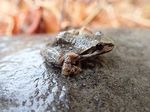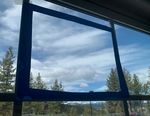TAHOME NATURE EDUCATION: TAHOE SKIES GRADES K-2
←
→
Page content transcription
If your browser does not render page correctly, please read the page content below
TaHome Nature Education: Tahoe Skies
Grades K-2
Reading: Cloudy, Clear, and Colorful Skies
Earth
During the day, our skies are filled by the sun, clouds, tiny pieces of dust and
debris, and invisible gasses. The gasses form a thin layer around the earth called
the atmosphere. The atmosphere gives us air to breathe and keeps the earth
warm by trapping heat like a blanket. We see all kinds of different clouds in the
atmosphere, from white and fluffy to dark and stormy.
Atmosphere
(not to scale)
Around Tahoe, we often see
clouds over the mountains that look like UFOs. Clouds are made of
water and can float in the sky even when they are very heavy
because warm air rises from the Earth and lifts them up. Clouds
form at different heights in the sky. The highest clouds can be
16,000 feet higher than Tahoe. Because it is so cold up there, high
clouds are made up of ice instead of water. Because of gravity,
when the water in clouds collects and becomes too heavy to float, it
starts to fall as rain, snow, or hail.
Have you ever noticed dust in the air when the sun shines brightly? All this dust, as well as the invisible gases in the air,
blocks the sun's direct light, and scatters it into a rainbow of colors of light. If you use a special crystal called a prism, you
can see the rainbow of colors hidden in the sun’s light.
Sometimes rain drops act like a prism. When sunlight hits them,
they show all the colors hidden in the white sunlight, making a
rainbow. That is why you see rainbows when it is both sunny and
rainy.
The dust in the air that scatters sunlight makes it so we see
different colors in the sky. During the day we see the blue light in
the sky. At sunset and sunrise, the light from the sun has to travel
through more atmosphere to get to our eyes. More blue light gets
stuck in the atmosphere before it reaches our eyes, and instead
we see red, pink, orange, and yellow light.
Copyright Tahoe Institute for Natural Science 2020Looking up into Tahoe's night sky we can see stars, planets, clouds, and
the moon. Stars, including the sun, make their own light. The moon and
planets can’t make their own light, but we can see them because they
reflect light from the sun like a mirror. Venus has been very big and bright
in the western sky each evening. Have you seen it lately?
Long ago people looked for shapes in the night sky by connecting stars.
These shapes may look like people, animals, or objects and are called
constellations. People created stories about how constellations came to
be.
Often, we can’t see the stars from where we are on Earth because of light
pollution. Before electricity and artificial light, people could look up on a The Big Dipper
clear night and see billions of stars without leaving the city. We are lucky
to have very little light pollution in the Tahoe region. In places where many people live, outdoor light from street lights,
homes, and stores create glare. All of these lights across a town or city combine to create skyglow, which blocks their
view of the stars. Light pollution can also harm animals, exposing some to their predators at night, interfering with the
daily schedules of breeding frogs and birds, confusing insects, and causing migrating birds to lose their way.
Sierran Tree Frog
Light Pollution
Copyright Tahoe Institute for Natural Science 2020Activities for Grade K-2
Create a Cloud
First, collect these materials:
• A tall, clear glass jar or cup
• Warm water
• Metal tray filled with ice or frozen ice pack
• A match or a lighter and small, thin, dry stick
Next, read all of the instructions below before you begin your
experiment.
1. Fill your glass or jar with a couple inches of the warm water. This
water will form water vapor like in the atmosphere on earth.
2. With an adult helper, light a match or small stick. Blow out the
flame, but quickly drop the match into the jar while it is smoking.
Smoke from the match will create gasses and dust like those in
Earth’s atmosphere. These are what water vapor attach themselves
to when it turns to liquid water.
3. Cover the whole top of the jar with your tray of ice or ice pack, and
try to make a tight seal. This makes the air at the top of the jar cold,
like the air at high elevations.
4. Watch the jar carefully, especially near the top.
5. After a minute, look at the top of the jar and lift the ice tray or pack
off just a little bit. What do you see coming out of the jar?
6. Next take the ice all the way off and watch what comes out of the jar.
Tell a family member your answers to these questions:
1. What happened in the jar with the ice on top?
2. What happened when you lifted the ice off of the top?
Track the Sky
Would you rather track stars and planets or clouds and rainbows out
your window? Choose whether you want to do this activity during the
day or at night.
1. Cut out or tape together a frame from a piece of paper or old
cereal box. You can also create a frame with masking tape.
2. Find a window in your home that has a view of the sky. Tape
your frame to the window so that when you look through the
frame you see as much sky as possible.
3. Choose a time of day that you will look through your frame each
day for the next five days, like right after dinner.
Copyright Tahoe Institute for Natural Science 20204. Tell a family member one thing you think you will see in your
frame.
5. For five days write down or draw a picture of what you see each
day.
After five days of looking through the frame, talk about these questions
with a family member:
1. What are all of the things you saw?
2. What was the most surprising thing you saw?
3. What did you see the most of?
If you would like to learn more, try this activity again at a different time of
day or in a different window.
Watch the Sunset
Watch a sunset with a family member. At Tahoe, the crest of the Sierra
Nevada can block much of the sunset, so the best views can be had from the east side of Lake Tahoe or Truckee. The
time of Tahoe's sunset changes each day as the earth revolves around the sun throughout the year. Look up the time of
sunset in your town for the night. Go out and begin to
watch the sky around the setting sun at least 20 minutes
before the sunset time. Be careful to not look directly at the
sun while it is still high in the sky, as that can hurt your eyes!
Watch until ten minutes past the setting of the sun. As you
watch, answer these questions with your family member:
1. What colors do you see in the sunset?
2. Are the colors changing as you watch?
3. Do you see any shapes in the sunset?
4. Do you see any colorful clouds?
5. Do you notice any animals or animal sounds around
you during the sunset?
Use what art supplies you have to paint, draw, or build the sunset you saw.
TINS wants to see your art! Have your parent post a photo of your art project to Facebook and tag Tahoe Institute for
Natural Science. You could also email the photo to us at kendal@tinsweb.org.
Copyright Tahoe Institute for Natural Science 2020Constellation Experiment
First, collect these materials:
• A box with a lid, such as a carboard shoe box. Or cut out one side of a cardboard box to use as a lid.
• Marker or pen
• A small screwdriver or something else that can poke holes through your lid
• A flashlight or the flashlight on a cell phone
Follow these instructions:
1. On the lid of your box, draw your own constellation, or learn about a
real constellation that you want to draw. Think of a shape you want your
constellation to be, like your favorite animal. Draw that animal on the lid.
Then, draw dots on the outline of your drawing, every inch or two around
your drawing. These dots are like the stars that make up a constellation.
2. With adult help, poke a hole all the way through the lid on each dot of
your constellation.
3. Place a lit flashlight inside the box, facing up. Put the lid on the box.
4. In a dark room, turn off all of the lights and observe your constellation.
5. After a minute in the dark, turn the lights back on. Can you see your
constellation now?
After your experiment, talk about these questions with a family member:
1. Was it easier to see the starlight from your constellation with the
lights on or off?
2. Can you see any stars or constellations from your house?
3. What is the best window in your house for looking at the night
sky?
Bonus Activity: Night Sky Scavenger Hunt
Ask your parents if you can stay up late one night until it gets dark out. Head outside with your family to find as many of
the things below as you can:
• The moon
• A planet (you can tell it is a planet because its light DOES NOT twinkle). Try and find Venus!
• The Big Dipper Constellation
• Find Orion before it's gone for the summer
• A star (you can tell it is a star because it DOES twinkle)
• A moth (Hint: nocturnal insects are often attracted to porch lights)
• Any other nocturnal animal
Copyright Tahoe Institute for Natural Science 2020Words to Know: Glossary
Prism
atmosphere: a mass of gases surrounding a planet
water vapor: water after it boils or evaporates to become gas in the air
constellation: a group of stars that form a shape or pattern
planet: something in space that goes around the sun
prism: a glass or crystal in a special 3-Dimensional shape
el prisma
Palabras para conocer
la constelación: un grupo de estrellas
la planeta: cuerpo celeste que gira alrededor del sol
la atmósfera: el aire sobre una planeta
el vapor de agua: agua que es un gas en el aire
el prisma: cuerpo geometrico de cristal
Further Learning
• Watch this video to learn more about light waves and why the sky is blue.
• Learn about the names of different kinds of clouds.
• Conduct this raincloud experiment.
• Watch this video for more information on why the sunset is so colorful.
• Learn how to make your own rainbow.
• Download a night sky app to find the constellations and various stars are in your sky.
• Read the legends of constellations.
• Learn more about light pollution and how to reduce yours by exploring this website.
Photo credit: Keith Thomas, Janet Delight, WikiCommons, and TINS
Copyright Tahoe Institute for Natural Science 2020You can also read



























































